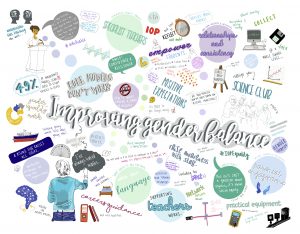Tiring of Twenty
For the past 30 years, girls have made up only 20 % of physics A-Level classrooms. Women make up only 9 % of professional engineers and only 11 % of physics professors. Dr Jess Wade reports back with some new, and very good news, from the launch of the Improving Gender Balance report from the Institute of Physics.
“You are forgiven for thinking you have heard it all before- it is because you have. There’s a skills gap (yawn), girls don’t like engineering (:-zzzzz) and what they really need is role models (please change the record!). What is surprising is that, for a bunch of scientists, we haven’t been very scientific in how we solve it. We have spent hundreds of millions of pounds on a number of well-intentioned campaigns, before doing the data collection and analysis- and we have had very little impact. Well, after ten years of working on Improving Gender Balance, the Institute of Physics are pretty proud of their results.
Amongst teachers, equality advocates and friends, the IOP reflected upon their journey so far. It all started with them setting up the Stimulating Physics Network: a partnership of physics teachers across the country, who were invited to free CPD and networking meetings. The Stimulating Physics Network worked, a bit, increasing the proportion of girls in physics from 17 to 23 %. But this wasn’t enough- and amongst their data, the IOP unearthed the most miserable headline of all- half of state maintained schools sent zero girls to do A-Level physics. What we have been trying – lunchtime science talks, showcasing super-star role models and making physics more ‘pink’ – well, hasn’t worked so well. Inspirational speakers who resonate with their audiences can make a big impact for the students who engage; the voice of a one-off visitor is not going to drown-out the daily messages of teachers and parents. This aligns with Science Grrl’s epic Through Both Eyes report, which highlights the impact of culture on girls’ choices.
The IOP are not only collecting data or running teacher training; they are Opening Doors for girls in schools. Based upon classroom case studies, they created a 9-step approach to counter gender stereotyping in school. The three-strand Improving Gender Balance (IGB) project has worked with girls, developing confidence and resilience (strand A), the physics classrooms (strand B) and the whole school (strand C). Where students and staff were made aware of, and addressed, gender stereotyping, things started to change. Through school surveys and policy audits, schools conducted their own data analysis. The results were fascinating: girls were more likely to ask questions, but boys were more than four times as likely to call out answers. The IOP worked with schools to make options evenings useful for students and their parents, and the girls became empowered; they conducted their own research projects, delivered assemblies and spoke about equality in PSHE. Sixth form students ran science club for the lower school, display boards were diversified and careers were integrated into lessons. After two years, the numbers of girls studying physics A-Levels tripled.
The IOP Education Team recognised the hardest work likely occurred when their project officers were not in the schools, and instead of spending more time talking ‘around the problem’, almost the entire event was led by teachers. UK teachers are facing big challenges: school budgets are being cut, there are more students in each class and there aren’t enough trainees. The Guardian recently reported that 82 % of UK teachers felt their workload was ‘unmanageable’. Despite these pressures, involvement in the project has clearly energised this cohort; their students are happy, their staffrooms are become more inclusive and people are starting to talk about diversity.
As you can tell, I am mega-impressed. As the world becomes increasingly frightening and restrictive, there is one project that gives me cause for hope, and it is being led by the Institute of Physics. Read the full report here.
Massive thanks to everyone involved at the Institute of Physics for their commitment, patience and care. Thank you to all of the schools that took part in the project and contributed to such a successful launch.”

